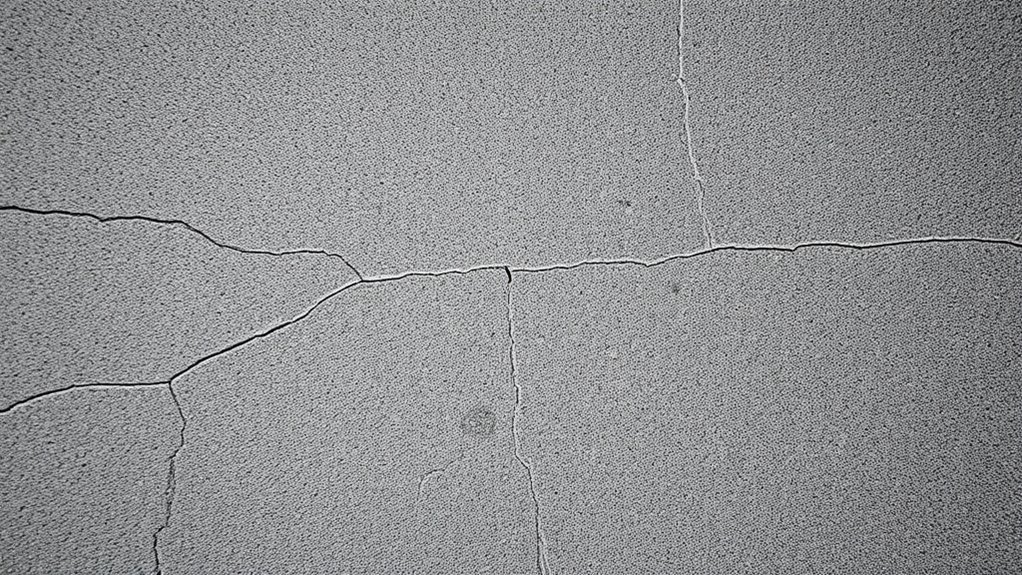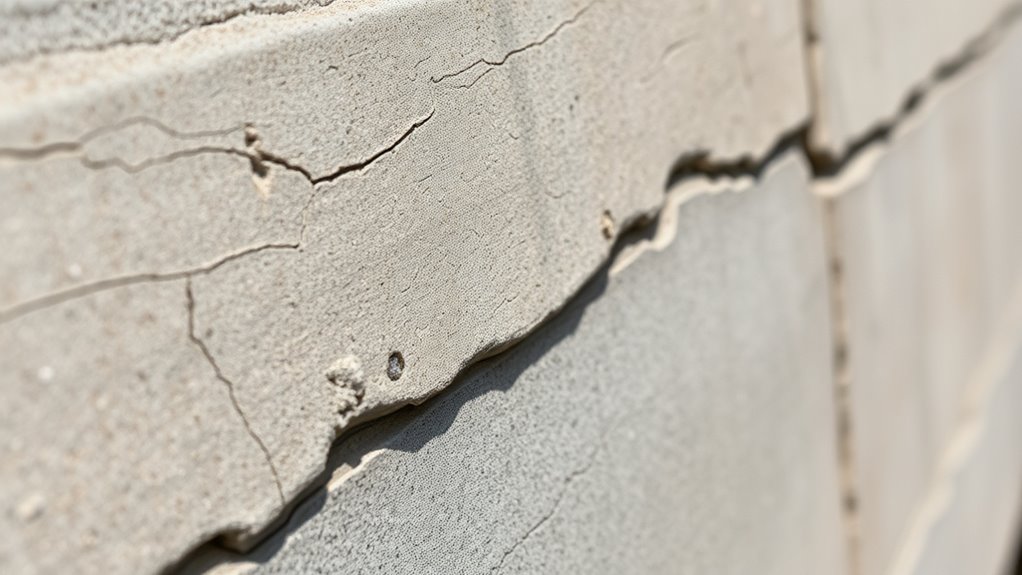Foundation cracks are common, especially in new homes, with small, hairline cracks under 1/16 inch that usually mean natural settling. However, wider cracks over 1/4 inch, especially those that run diagonally or across walls, can signal more serious shifting or structural issues. Watch for changes, such as widening or accompanying signs like sticking doors or water leaks. To protect your home, understanding these signs helps you act early—if you want to learn more, keep exploring these indicators.
Key Takeaways
- Small, hairline cracks less than 1/16 inch are usually normal and related to settling.
- Cracks wider than 1/4 inch or rapidly widening often indicate structural issues.
- Vertical or diagonal cracks near door and window frames may signal movement needing attention.
- Jagged, irregular cracks or those accompanied by uneven floors suggest stress on the foundation.
- Regular monitoring and professional assessment are essential to determine if cracks are benign or problematic.

Have you noticed cracks forming in your foundation? If so, it’s natural to feel concerned. Cracks can signal a range of issues, from minor settling to serious structural problems. The key is understanding which cracks are normal and which require immediate attention. Small, hairline cracks that appear on basement walls or concrete slabs are often part of the natural settling process. As your house settles into its foundation over the first few years, slight cracks can develop without indicating any danger. These typically remain narrow—less than 1/16 inch wide—and don’t grow larger over time. If your home is relatively new, these minor cracks are usually nothing to worry about, but keep an eye on them to make sure they don’t deepen or widen.
Small, hairline cracks in new homes often indicate normal settling, but monitor for widening or deepening over time.
In contrast, wider cracks, especially those exceeding 1/4 inch, are more concerning. Vertical or diagonal cracks that suddenly appear or expand over time suggest that your foundation might be shifting or experiencing stress. These cracks can compromise the stability of your home if left unchecked. Look for cracks that run across basement walls or floors, as well as those that form near door frames or windows. If you notice that a crack extends from the corner of a window or door opening and is accompanied by sticking doors or windows, it could indicate significant foundation movement. These signs shouldn’t be ignored. Foundation issues can worsen quickly, potentially leading to costly repairs or safety hazards.
Another warning sign is if you find cracks that are jagged or irregular in shape rather than smooth and straight. Such cracks can point to underlying structural problems, especially if they are accompanied by other symptoms like uneven floors, gaps around moldings, or sloping walls. Additionally, if cracks are accompanied by moisture, mold, or water leaks, it’s a sign that your foundation may be compromised and needs professional assessment. Recognizing structural stress early can help prevent more serious damage.
Always remember that foundation cracks are not automatically a disaster. Many are benign and part of normal house aging or settling. However, it’s vital to stay vigilant. Regular inspections can help you distinguish between harmless cracks and those that signal deeper issues. When in doubt, consult a foundation specialist or structural engineer. They can evaluate the severity of the cracks and recommend appropriate repairs, guaranteeing your home remains safe, stable, and secure for years to come.
Frequently Asked Questions
How Do Foundation Cracks Affect Property Value?
Foundation cracks can lower your property’s value because buyers see them as potential signs of structural issues. If the cracks are significant or indicate ongoing settlement, it suggests repairs are needed, making your home less attractive. However, small, superficial cracks often don’t impact value much. Addressing the cracks early and getting professional assessments can help preserve your property’s worth and reassure potential buyers of its stability.
Can Foundation Cracks Lead to Structural Failure?
Foundation cracks are like tiny fractures in a glass, often harmless but sometimes signaling bigger issues. If you ignore significant or widening cracks, they can lead to structural failure, causing walls to bow or floors to sag. You should regularly inspect your foundation and consult a professional if cracks are deep, wide, or growing. Addressing problems early prevents costly repairs and keeps your home safe and stable.
What Are the Costs Associated With Foundation Repair?
The costs for foundation repair vary depending on the extent of damage, location, and repair method. Typically, you might spend between $2,000 and $7,000, but more extensive issues can cost $10,000 or more. You’ll need to budget for inspections, potential excavation, underpinning, or piering. Always get multiple quotes and consult a professional to understand the specific repairs your foundation needs and their associated costs.
How Long Does Foundation Crack Repair Typically Take?
Think of foundation crack repair as healing a broken bridge. It usually takes anywhere from a day to a week, depending on crack size and severity. Small, hairline cracks may be fixed in a few hours, while larger, more complex issues could require several days. You’ll find that prompt action helps speed things up, so don’t delay calling in experts to restore your home’s stability quickly and confidently.
Are There Preventative Measures to Avoid Future Cracks?
To prevent future foundation cracks, you should schedule regular inspections and keep water away from your foundation by maintaining proper drainage. Fix any drainage issues promptly, and ensure gutters and downspouts direct water away from your home. Additionally, control soil moisture levels around your foundation by watering during dry periods and avoiding excessive watering. Investing in these preventative measures helps maintain stability and reduces the risk of new cracks forming.
Conclusion
Remember, a little crack now and then is normal, but don’t ignore serious signs. Keep an eye on your foundation and address issues early—timing is everything. As the saying goes, “A stitch in time saves nine.” By staying proactive, you can prevent small problems from turning into costly repairs. Regular inspections and prompt repairs help keep your home solid and secure. Trust your instincts and don’t wait until cracks become crises.









